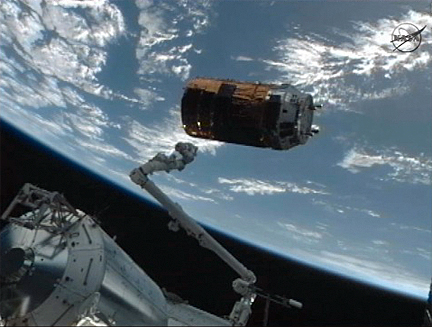Japanese cargo ship reaches space station
07/27/2012 11:17 AM Filed in: Space News | International Space Station
By WILLIAM HARWOOD
CBS News
Wielding the International Space Station's robot arm, astronaut Joseph Acaba captured a Japanese cargo ship early Friday, one week after launch from the Tanegashima Space Center in southern Japan. With the HTV-3 spacecraft firmly locked to the end of the arm, Japanese astronaut Akihiko Hoshide took over, maneuvering it to an Earth-facing port on the station's forward Harmony module for berthing.
"HTV capture is complete," Hoshide called down after the spacecraft was grappled at 8:23 a.m. EDT (GMT-4). "Congratulations to all the teams in Houston and (Japan)."
Spectacular video from the station showed the bus-size HTV suspended against the black backdrop of space as the two spacecraft sailed 253 miles above the southern Indian Ocean.
"Congratulations on a great capture. We'd like to welcome Kounotori aboard," astronaut Catherine Coleman replied from Houston, referring to the cargo craft's Japanese nickname -- "white stork."
After carefully aligning the HTV's forward hatch with Harmony's Earth-facing port, a gang of motorized bolts were driven home to lock the spacecraft in place by 10:34 a.m. Hatches were scheduled to be opened Saturday, but the astronauts were running ahead of schedule and they had the option of entering the craft earlier if time allowed.
Developed by the Japan Aerospace Exploration Agency, or JAXA, as a contribution to the space station program, the HTV is designed to carry both pressurized and unpressurized cargo, including equipment too big to pass through the space station's hatches.
Making the program's third flight, the HTV is loaded with 3.9 tons of pressurized cargo, including a research aquarium, five small "CubeSat" satellites and their launcher, a catalytic reactor for the station's water processing system and a water pump. Also on board: Japanese food, beverages and crew clothing.
The HTV is carrying another 1.2 tons of gear in its unpressurized section, including experimental NASA communications hardware and instruments and sensors that will be mounted outside the Japanese Kibo lab module.
The flight plan calls for the cargo ship to remain in place until Sept. 6.
CBS News
Wielding the International Space Station's robot arm, astronaut Joseph Acaba captured a Japanese cargo ship early Friday, one week after launch from the Tanegashima Space Center in southern Japan. With the HTV-3 spacecraft firmly locked to the end of the arm, Japanese astronaut Akihiko Hoshide took over, maneuvering it to an Earth-facing port on the station's forward Harmony module for berthing.
 |
| The HTV-3 cargo ship, moments before capture by the International Space Station's robot arm. (Photo: NASA TV) |
Spectacular video from the station showed the bus-size HTV suspended against the black backdrop of space as the two spacecraft sailed 253 miles above the southern Indian Ocean.
"Congratulations on a great capture. We'd like to welcome Kounotori aboard," astronaut Catherine Coleman replied from Houston, referring to the cargo craft's Japanese nickname -- "white stork."
After carefully aligning the HTV's forward hatch with Harmony's Earth-facing port, a gang of motorized bolts were driven home to lock the spacecraft in place by 10:34 a.m. Hatches were scheduled to be opened Saturday, but the astronauts were running ahead of schedule and they had the option of entering the craft earlier if time allowed.
Developed by the Japan Aerospace Exploration Agency, or JAXA, as a contribution to the space station program, the HTV is designed to carry both pressurized and unpressurized cargo, including equipment too big to pass through the space station's hatches.
Making the program's third flight, the HTV is loaded with 3.9 tons of pressurized cargo, including a research aquarium, five small "CubeSat" satellites and their launcher, a catalytic reactor for the station's water processing system and a water pump. Also on board: Japanese food, beverages and crew clothing.
The HTV is carrying another 1.2 tons of gear in its unpressurized section, including experimental NASA communications hardware and instruments and sensors that will be mounted outside the Japanese Kibo lab module.
The flight plan calls for the cargo ship to remain in place until Sept. 6.